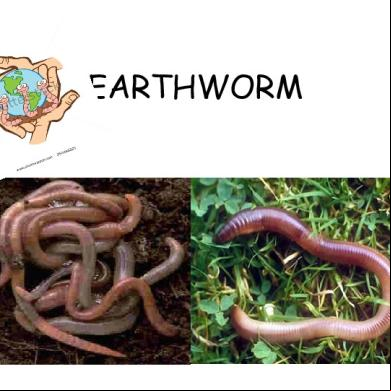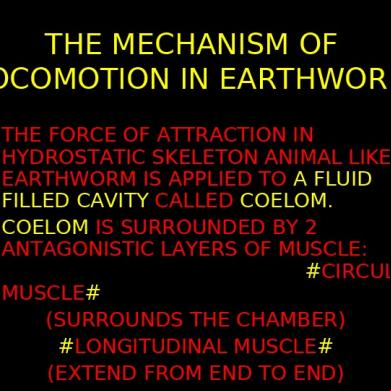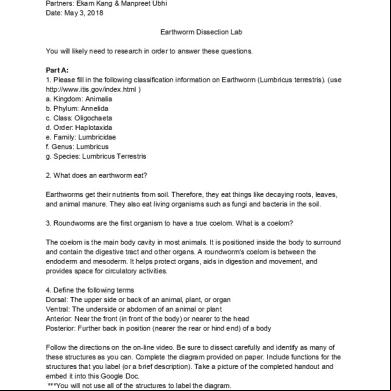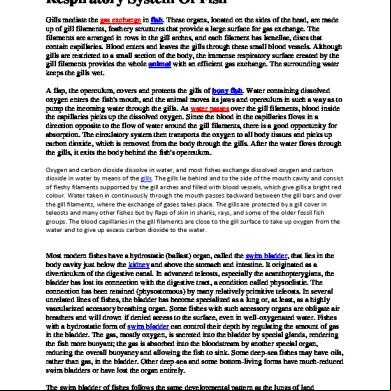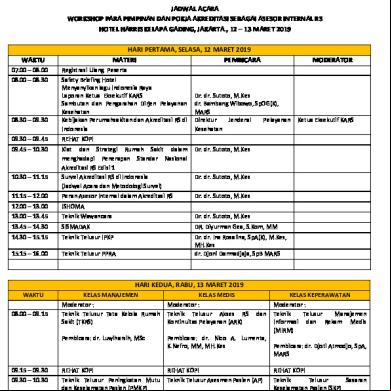Earthworm Ppt 296l2z
This document was ed by and they confirmed that they have the permission to share it. If you are author or own the copyright of this book, please report to us by using this report form. Report 3i3n4
Overview 26281t
& View Earthworm Ppt as PDF for free.
More details 6y5l6z
- Words: 755
- Pages: 23
EARTHWORM
INTRODUCTION PHYLUM:Annelida CLASS:Oligochaeta
ORDER:Opisthopora FAMILY:Megascolecidae GENUS:Pheretima SPECIES:posthuma
HABITAT • Living in moist places • Comes out at night in damp cloudy weather
What do earthworm eat? • soil, sand or mud as they tunnel through it. • dead leaves and other bits of plants.
EXTERNAL MORPHOLOGY Bisymmetrical animal Mature worm is about 150mm in length and 35mm in width Body is divided into 100-120 segments called metameres Brown colour of worm is due to the porphyrin
EXTERNAL MORPHOLOGY The first segment is called Prostomium Clitellum surrounds the segment 14-16 Middle of each segment there is a ring called Setae Spermathecal aperatus is four pair of aparatus
EXTERNAL MORPHOLOGY I4th segment is female apperatus 18 th segment is male apperatus Papillia bears a swallow cup like depression acts as sucker during copulation Seminal grove helps to produce and store sperm
LOCOMOTION Begins at the anterior end and travels posteriorly.the earthworm travels 25cm in one minute… circular muscle contract and longitudinal muscle relax and body become thinner and longer and producing peristaltic waves along the body.the wave begins in front and
DIGESTIVE SYSTEM Buccal is situated to the middle of 3rd segment Pharynx acts as suction pump to drawing in food items Oesophagus is a short narrow thin walled tube In Crops foods are stored Hard oval and thick walled ogan is gizzard. Intestine is long and thick.villi are also present there.
•
CIRCULATORY Closed circulatory SYSTEM
system.haemoglobin occurs dissolved in plasma.It gives the red colour to blood • Dorsal vessel is the largest blood vessel.It has muscular thick wall.Blood flows through it from backward to forward • Ventral vessel is thin.Non contractile.Blood flows through it posteriorly.
•
CIRCULATORY SYSTEM Lateral oesophegal
vessel lying on ventral lateral side of gut and running from the anterior end of the body. • Anterior loop helps to move blood from lateral oesophageal vessel to supra oesophageal vessel. • Hearts are thick muscular rhythmically contractile vertical vessel. • Heart of 7th and 9th
•
CIRCULATORY SYSTEM Behind the 13 segment th
there is a pair of Commissural vessel. • Ventral vessel is the main distributing vessel and lateral oesophageals and supra oesophageals are main collecting vessel.
Excretory system
• Excretion affected by Nephridia. • Small size nephridia are called micro nephridia and large size are called meganephridia. • Pharyngeal nephridia occurs at the side of pharynx and oesophagus.They are also Enteronephric nephridia. • Septal nephridia are the
•
EXCRETORY There are 200-250 SYSTEM
Integumentary nephridia in each segment.They are microscopic.They are exonephric. • Excretory fluid contains 40% urea.So earthworm is ureotelic.
RESPIRATIO N
• Intake of O2 and giving out CO2. • Respiration takes place in blood capilaries • Haemoglobin dissolved in plasma of blood acts as a respiratory pigment.
REPRODUCTIVE SYSTEM MALE REPRODUCTION • In Earthworms, cross fertilization takes place.It is proceeded by copulation. • Testes are present in 2 pair,white and lobed.Testes are well formed only in young ones but become degenerated in adults. • Testes sacs are present with both of the testes .Each testis enclose a pair of testic and a pair of cilliated
Male reproduction • There are 2 pair of large seminal vessel.Each vessel communicate with testes sac. • Each seminal funnel opens in a cilliated sperm duct called vasa difertia. • There are 2 prostatic gland.They has small curve duct which s with spermatic duct and opens through male genital aperture at 18th segment. • There are 2 pair of accessory
FEMALE REPRODUCTION
• A pair of ovary is situated.Each ovary contains ova in series.Mature ova are found towards the end and immature ova are found on the base of the ovary • Oviducal funnel is large.Each oviducal funnel into short conical tube called oviduct. • Spermathaceae has 4 pairs.they store sperms after collecting from male.
COPULATION • In rainy season ,two earthworm copulate at night.they get attached by their ventral surface .Male genital aperture become eracted and inserted into spermathecal pore of each other.During this process sperms are exchanged.This is called copulation.
COCOON FORMATION
• After copulation a membrane is secreted around clitellum by membrane secreting gland.The membrane is laid out on the ground.The elastic structure is called cocoon.Within cocoon one of the sperm fertilized with a ovum to form zygote.Young worm developed and comes out from the cocoon in about 2-3 weeks.
BENEFITS • They are the food of hunting birds,lizards,snakes. • They used to fed aquarium fishes. • They are farmer’s friend in agricultural field. • They are helpful to soil cultivation.
THANK YOU
INTRODUCTION PHYLUM:Annelida CLASS:Oligochaeta
ORDER:Opisthopora FAMILY:Megascolecidae GENUS:Pheretima SPECIES:posthuma
HABITAT • Living in moist places • Comes out at night in damp cloudy weather
What do earthworm eat? • soil, sand or mud as they tunnel through it. • dead leaves and other bits of plants.
EXTERNAL MORPHOLOGY Bisymmetrical animal Mature worm is about 150mm in length and 35mm in width Body is divided into 100-120 segments called metameres Brown colour of worm is due to the porphyrin
EXTERNAL MORPHOLOGY The first segment is called Prostomium Clitellum surrounds the segment 14-16 Middle of each segment there is a ring called Setae Spermathecal aperatus is four pair of aparatus
EXTERNAL MORPHOLOGY I4th segment is female apperatus 18 th segment is male apperatus Papillia bears a swallow cup like depression acts as sucker during copulation Seminal grove helps to produce and store sperm
LOCOMOTION Begins at the anterior end and travels posteriorly.the earthworm travels 25cm in one minute… circular muscle contract and longitudinal muscle relax and body become thinner and longer and producing peristaltic waves along the body.the wave begins in front and
DIGESTIVE SYSTEM Buccal is situated to the middle of 3rd segment Pharynx acts as suction pump to drawing in food items Oesophagus is a short narrow thin walled tube In Crops foods are stored Hard oval and thick walled ogan is gizzard. Intestine is long and thick.villi are also present there.
•
CIRCULATORY Closed circulatory SYSTEM
system.haemoglobin occurs dissolved in plasma.It gives the red colour to blood • Dorsal vessel is the largest blood vessel.It has muscular thick wall.Blood flows through it from backward to forward • Ventral vessel is thin.Non contractile.Blood flows through it posteriorly.
•
CIRCULATORY SYSTEM Lateral oesophegal
vessel lying on ventral lateral side of gut and running from the anterior end of the body. • Anterior loop helps to move blood from lateral oesophageal vessel to supra oesophageal vessel. • Hearts are thick muscular rhythmically contractile vertical vessel. • Heart of 7th and 9th
•
CIRCULATORY SYSTEM Behind the 13 segment th
there is a pair of Commissural vessel. • Ventral vessel is the main distributing vessel and lateral oesophageals and supra oesophageals are main collecting vessel.
Excretory system
• Excretion affected by Nephridia. • Small size nephridia are called micro nephridia and large size are called meganephridia. • Pharyngeal nephridia occurs at the side of pharynx and oesophagus.They are also Enteronephric nephridia. • Septal nephridia are the
•
EXCRETORY There are 200-250 SYSTEM
Integumentary nephridia in each segment.They are microscopic.They are exonephric. • Excretory fluid contains 40% urea.So earthworm is ureotelic.
RESPIRATIO N
• Intake of O2 and giving out CO2. • Respiration takes place in blood capilaries • Haemoglobin dissolved in plasma of blood acts as a respiratory pigment.
REPRODUCTIVE SYSTEM MALE REPRODUCTION • In Earthworms, cross fertilization takes place.It is proceeded by copulation. • Testes are present in 2 pair,white and lobed.Testes are well formed only in young ones but become degenerated in adults. • Testes sacs are present with both of the testes .Each testis enclose a pair of testic and a pair of cilliated
Male reproduction • There are 2 pair of large seminal vessel.Each vessel communicate with testes sac. • Each seminal funnel opens in a cilliated sperm duct called vasa difertia. • There are 2 prostatic gland.They has small curve duct which s with spermatic duct and opens through male genital aperture at 18th segment. • There are 2 pair of accessory
FEMALE REPRODUCTION
• A pair of ovary is situated.Each ovary contains ova in series.Mature ova are found towards the end and immature ova are found on the base of the ovary • Oviducal funnel is large.Each oviducal funnel into short conical tube called oviduct. • Spermathaceae has 4 pairs.they store sperms after collecting from male.
COPULATION • In rainy season ,two earthworm copulate at night.they get attached by their ventral surface .Male genital aperture become eracted and inserted into spermathecal pore of each other.During this process sperms are exchanged.This is called copulation.
COCOON FORMATION
• After copulation a membrane is secreted around clitellum by membrane secreting gland.The membrane is laid out on the ground.The elastic structure is called cocoon.Within cocoon one of the sperm fertilized with a ovum to form zygote.Young worm developed and comes out from the cocoon in about 2-3 weeks.
BENEFITS • They are the food of hunting birds,lizards,snakes. • They used to fed aquarium fishes. • They are farmer’s friend in agricultural field. • They are helpful to soil cultivation.
THANK YOU
